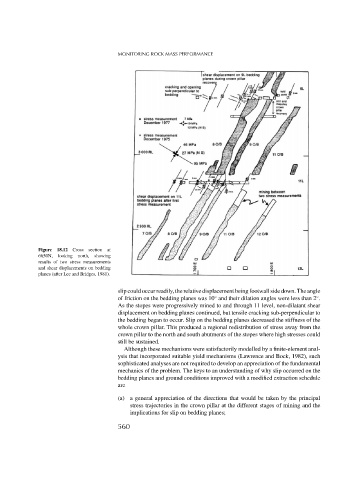Page 578 - Rock Mechanics For Underground Mining
P. 578
MONITORING ROCK MASS PERFORMANCE
Figure 18.12 Cross section at
6650N, looking north, showing
results of two stress measurements
and shear displacements on bedding
planes (after Lee and Bridges, 1981).
slip could occur readily, the relative displacement being footwall side down. The angle
◦
◦
of friction on the bedding planes was 10 and their dilation angles were less than 2 .
As the stopes were progressively mined to and through 11 level, non-dilatant shear
displacement on bedding planes continued, but tensile cracking sub-perpendicular to
the bedding began to occur. Slip on the bedding planes decreased the stiffness of the
whole crown pillar. This produced a regional redistribution of stress away from the
crown pillar to the north and south abutments of the stopes where high stresses could
still be sustained.
Although these mechanisms were satisfactorily modelled by a finite-element anal-
ysis that incorporated suitable yield mechanisms (Lawrence and Bock, 1982), such
sophisticated analyses are not required to develop an appreciation of the fundamental
mechanics of the problem. The keys to an understanding of why slip occurred on the
bedding planes and ground conditions improved with a modified extraction schedule
are
(a) a general appreciation of the directions that would be taken by the principal
stress trajectories in the crown pillar at the different stages of mining and the
implications for slip on bedding planes;
560

